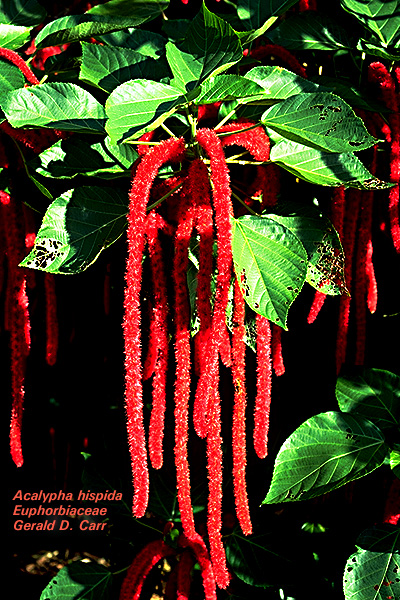 |
Jatropha integerrima, rose-flowered jatropha. This is an example
of an ordinary inflorescence of unisexual flowers. The male flowers have a monadelphous
androecium of 10 stamens and the female flowers have a tricarpellate pistil and vestigial
stamens. Both types of flowers have a biseriate perianth of sepals and petals. |
 |
Ricinus communis, castor bean. This very poisonous plant which
provides castor oil is naturalized in Hawaii. Notice the female flowers in the upper part
of the inflorescence and the male flowers below. Petals are absent and the calyx is
caducous. The tiny stamens are very numerous, up to 1,000 per staminate flower. |
 |
Phyllanthus debilis, niruri. Although not as showy as the
preceding example, the flowers here are fairly normal in appearance. Two open male flowers
can be seen on the left and three open female flowers are on the right. Small stipules are
also visible. |
 |
Hura crepitans, sandbox tree. This unusual species has the
female flower reduced to a naked pistil with a reddish peltate stigma as visible near the
top left of the photo. A cone-like cluster of reddish male flowers is nearby. The fruit is
also exceptional as it has many carpels that separate explosively into 1-seeded segments. |
 |
Acalypha hispida, chenille plant. Shrub, probably from the E.
Indies, with long pendulous catkins of female flowers with feathery stigmas. Male flowers
seldom appear on this species in Hawaii. |
 |
Acalypha wilkesiana, copper leaf, Jacobs coat, beefsteak plant.
Shrub from Fiji with red-mottled, bronzy-green. leaves and tiny flowers. Many cultivars
are grown for the ornamental value of the foliage. Location: Ewa-Mauka corner of St. John. |
 |
Manihot esculenta, tapioca, cassava, manioc. Shrub from Brazil,
widely cultivated in the tropics for its large, tuberous roots that provide an excellent
source of starch. |
|
Aleurites moluccana, kukui, candle nut tree. A polynesian tree
probably brought to Hawaii by early polynesian settlers. Official tree of the State of
Hawaii. One of the most important plants of the old Hawaiians, the kukui was used for
light, canoes, fishing, tanning, leis, catching birds, and as a source of food, medicine
and dye. The pale green foliage of kukui trees, which commonly grow at the head of hanging
valleys, stands out from great distances. |
 |
Euphorbia sp. This is an example of a specialized, miniature
inflorescence that mimics a single flower. The general term for this condition is a
pseudanthium but in this family the pseudanthium is so specialized it is called a
cyathium. It consists of a single central naked female flower surrounded by cymes of naked
male flowers each consisting of a single stamen. These naked flowers are surrounded by a
cup-like involucre that bears glands and petal-like appendages, although in this species
they are not particularly showy. Note the three styles and milky latex also visible in the
photo. |
 |
Euphorbia sp. This is another example of the typical
pseudanthium or cyathium found in the family. Note the petal-like peripheral appendages
surrounding the unisexual flowers. It is characteristic for the single female flower in
the center to become deflexed to one side as it matures. Note the 3 style branches. |
 |
Euphorbia pulcherrima, poinsettia. This ornamental species has
very conspicuous red bracts associated with the cyathea. Notice also a large yellow gland
on the involucral cup of each cyatheum. |
 |
Euphorbia splendens, crown of thorns. Ornamental shrub from
Madagascar. Legend suggests that the bracts were white until the plant was worn by Christ
as the "crown of thorns," whereupon they became red. |
 |
Chamaesyce hypericifolia, graceful spurge. Note the cyatheum
structure, stipules, and milky sap. |
 |
Chamaesyce celastroides, akoko. Note the cyatheum structure and
milky sap at the extreme right in this endemic Hawaiian species. |